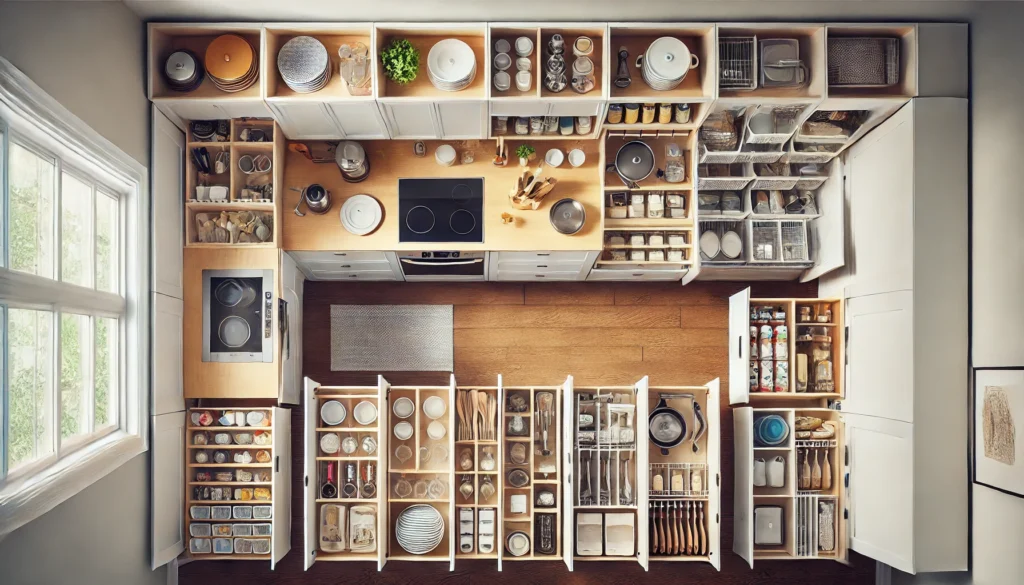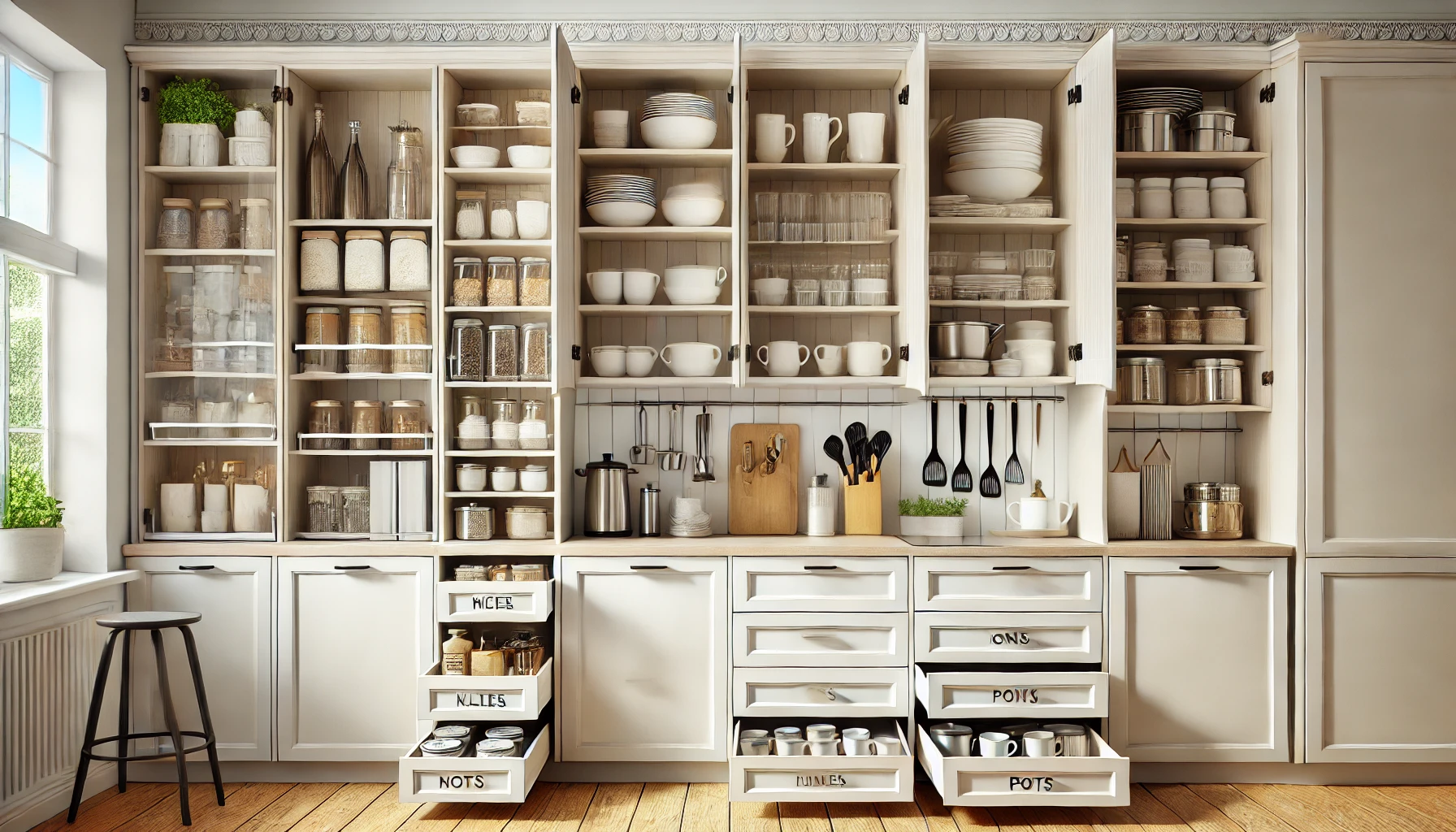A well-organized kitchen is essential for efficiency, convenience, and a clutter-free space. Arranging your kitchen cupboards properly allows you to find items quickly, reduces waste, and makes cooking more enjoyable. This step-by-step guide will help you declutter, categorize, and organize your kitchen cupboards effectively. Whether you have a large or small kitchen, these practical solutions will maximize storage space and keep your kitchen functional.
The Importance of an Organized Kitchen
A well-organized kitchen is more than just aesthetically pleasing—it significantly impacts your daily life. When your kitchen cupboards are arranged systematically, meal preparation becomes easier, and you avoid the frustration of searching for misplaced items.
An organized kitchen also prevents food waste. When ingredients are neatly stored, you can see what you have and use items before they expire. Additionally, a tidy kitchen promotes cleanliness, reducing the risk of pests or spoiled food accumulating in forgotten corners.
For those who cook regularly, an orderly kitchen enhances productivity. With everything in its place, you can move efficiently between tasks without unnecessary distractions. Whether you have a large kitchen with ample storage or a compact space requiring creative solutions, proper organization helps optimize your kitchen’s functionality.
Benefits of Arranging Your Cupboards Properly
Organizing your kitchen cupboards offers numerous benefits beyond just making your space look tidy. Here are some key advantages:
- Saves Time: When items have designated spots, you won’t waste time searching for ingredients, cookware, or utensils.
- Maximizes Space: Proper storage solutions make the most of available cupboard space, allowing you to fit more items without overcrowding.
- Reduces Stress: A clutter-free kitchen promotes a sense of order and calm, making cooking and cleaning less overwhelming.
- Minimizes Food Waste: Organized shelves ensure you use ingredients before they expire, reducing the chances of forgotten or spoiled food.
- Enhances Safety: Storing sharp objects, heavy cookware, and cleaning supplies in appropriate places prevents accidents and spills.
By implementing a structured system for your cupboards, you can create a kitchen that is both functional and visually appealing.
Tools and Supplies You’ll Need
Before you start organizing, gather the necessary tools and supplies to make the process smoother:
- Storage Bins and Baskets: Great for grouping similar items together and keeping smaller objects from getting lost.
- Shelf Risers: Help maximize vertical space by allowing you to stack dishes or cans efficiently.
- Labels and Markers: Essential for clear identification of pantry items and storage bins.
- Drawer Dividers: Keep utensils and cutlery neatly separated.
- Hooks and Racks: Perfect for hanging mugs, cooking tools, or lids inside cupboard doors.
- Lazy Susans: Ideal for storing spices, oils, and condiments for easy access.
- Cleaning Supplies: A microfiber cloth, all-purpose cleaner, and disinfectant for wiping down cabinets before rearranging.
Having these tools ready will ensure a seamless organization process.
Step 1: Declutter and Clean Your Cupboards
The first step to organizing your kitchen cupboards is decluttering. This involves removing all items, assessing what you have, and discarding or donating unnecessary items. A clean and clutter-free kitchen provides a fresh start for effective organization.
1.1 Empty All Your Cabinets
Before you can start organizing, you need to take everything out of your cupboards. This step allows you to see exactly what’s inside, making it easier to sort and categorize items.
Start by clearing off a large surface, such as your kitchen counter or dining table, to place all the contents. As you remove items, check for anything broken, expired, or unnecessary. Group similar items together so that you can evaluate how much storage space each category will require.
This process might seem overwhelming, but it’s necessary to get a clear picture of what you own. Many people are surprised by the amount of unused or duplicate items they have hiding in their cupboards.
Once everything is out, wipe down the shelves, remove any crumbs or stains, and consider adding shelf liners to protect your storage space.
1.2 Sort and Categorize Items
After emptying your cupboards, the next step is sorting and categorizing your kitchen essentials. This step makes it easier to determine what should stay and what should go.
Start by grouping similar items together:
- Dishes and Glassware: Plates, bowls, glasses, mugs
- Cookware and Bakeware: Pots, pans, baking sheets, mixing bowls
- Utensils and Cutlery: Spoons, forks, knives, measuring cups
- Pantry Staples: Flour, sugar, rice, canned goods
- Spices and Condiments: Seasonings, cooking oils, vinegar
- Small Appliances: Blender, toaster, coffee maker
As you sort through each category, separate items you use frequently from those you rarely need. Items you use daily should be placed in accessible spots, while seasonal or specialty items can be stored in higher cabinets.
Sorting your kitchen essentials now will make the organizing process much more manageable.
1.3 Discard or Donate Unnecessary Items
One of the most important aspects of organizing is decluttering. Holding onto unused or broken items only takes up valuable space.
- Check for Expired Food: Toss out anything past its expiration date.
- Donate Usable Kitchenware: If you have extra plates, cups, or small appliances you never use, consider donating them to a local charity.
- Get Rid of Broken or Duplicates: If you have three can openers but only use one, it’s time to part with the extras.
Be honest with yourself about what you really need. Keeping only the essentials will make your kitchen more functional.
1.4 Deep Clean the Cupboards
Once you’ve decluttered, it’s time to give your cupboards a deep clean. This step ensures your storage areas are fresh and free from dust, crumbs, and spills.
- Wipe Down Shelves: Use a damp microfiber cloth with mild soap or an all-purpose cleaner.
- Disinfect and Deodorize: If you notice any lingering odors, sprinkle baking soda inside the cupboard and let it sit for a few hours before wiping it away.
- Add Shelf Liners: These protect your cupboards from spills and scratches, making future cleaning easier.
A clean foundation is key to maintaining an organized kitchen in the long run.
Step 2: Plan the Best Layout for Your Kitchen Cupboards

Once your kitchen cupboards are decluttered and cleaned, the next step is to plan an efficient layout. Proper organization ensures that every item has a designated place, reducing clutter and improving accessibility. By assigning storage zones, using smart storage solutions, and organizing food properly, you’ll create a functional and well-structured kitchen.
2.1 Assign Cupboards Based on Functionality
The key to an organized kitchen is placing items where they make the most sense. When each cupboard is assigned a purpose, you can work more efficiently while cooking and cleaning.
Store Items Close to Where You Use Them
- Plates, bowls, and glasses should be near the dishwasher or sink for easy unloading.
- Pots and pans should be near the stove or oven for convenient access while cooking.
- Spices, oils, and seasonings should be stored close to your prep area for quick seasoning.
- Utensils and cutlery should be near your food prep space or dining area.
Keep Everyday Essentials Within Easy Reach
- Frequently used dishes and cookware should be on lower, easy-to-reach shelves.
- Rarely used items, like seasonal dishes or party platters, can go on higher shelves.
- Heavy appliances should be stored in lower cupboards to avoid lifting risks.
This step ensures that everything is where you need it, making cooking and cleaning more seamless.
2.2 Optimize Storage with Smart Solutions
Maximizing storage space in your kitchen is crucial, especially if you have limited cabinet space. Here are some smart storage solutions to help you optimize every inch:
Use Shelf Risers to Maximize Vertical Space
- Stack plates, bowls, and cups without wasting space.
- Separate smaller items like spice jars or canned goods for better visibility.
Install Pull-Out Organizers for Deep Cupboards
- Great for storing pots, pans, and lids without stacking them awkwardly.
- Helps prevent items from getting lost in the back of deep cabinets.
Utilize Hooks and Door Organizers
- Hang mugs, measuring cups, or cooking utensils inside cupboard doors.
- Use adhesive hooks for easy installation without damaging the cabinets.
By incorporating these storage hacks, you can keep your kitchen organized without overcrowding your cupboards.
2.3 Create a System for Food Storage
Properly organizing your pantry and food storage cupboards helps reduce food waste and makes meal prep easier.
Group Pantry Staples Together
- Store dry goods like flour, sugar, rice, and pasta in airtight containers.
- Keep canned goods in one section and stack them for easy access.
Use Clear Containers and Labels for Easy Identification
- Transparent containers make it easy to see what you have.
- Labels help prevent confusion and ensure items are used before expiration.
A well-organized food storage system ensures that you always know what’s available, reducing overbuying and expired food waste.
Read More: How much should a 10×10 kitchen remodel cost
Step 3: Arrange Items in an Efficient and Practical Manner
Now that you have a plan in place, it’s time to arrange your kitchen items in a way that makes sense for your daily routine. This step focuses on keeping your kitchen functional while maintaining an aesthetically pleasing layout.
3.1 Store Dishes and Glassware Properly
Properly storing dishes and glassware prevents breakage and ensures easy access.
Keep Plates and Bowls Stacked Neatly
- Stack similar-sized dishes to save space.
- Use shelf risers to separate different sets of plates.
Place Glasses and Mugs on a Secure Shelf
- Store mugs with handles facing the same direction for consistency.
- Arrange glasses in rows to prevent tipping and breakage.
An organized dish storage system ensures that setting the table and unloading the dishwasher are hassle-free.
3.2 Organize Cooking Essentials
A well-arranged cooking area improves efficiency during meal prep.
Store Pots and Pans Near the Stove
- Stack pots and pans using pan dividers to prevent scratching.
- Use a lid rack to keep lids organized and easy to find.
Arrange Utensils in a Drawer or Countertop Organizer
- Use drawer dividers to separate spoons, spatulas, and whisks.
- Keep commonly used tools within easy reach near your prep area.
By organizing your cooking essentials properly, you’ll save time and reduce frustration while preparing meals.
3.3 Keep Baking Supplies in One Spot
If you bake often, dedicating a section of your kitchen for baking ingredients and tools can streamline your process.
Dedicate a Cupboard for Baking Ingredients and Tools
- Store flour, sugar, and baking soda in airtight containers.
- Keep measuring cups and spoons nearby for convenience.
Use Labeled Bins for Flour, Sugar, and Other Baking Items
- Group ingredients together to avoid digging through multiple cabinets.
- Label everything to prevent confusion while baking.
Having a designated baking station makes it easier to find everything when you need it.
3.4 Organize Small Appliances Smartly
Appliances can take up valuable counter and cabinet space, so it’s important to store them efficiently.
Store Rarely Used Appliances in Upper or Lower Cabinets
- Keep seasonal appliances (such as slow cookers or ice cream makers) in out-of-reach cupboards.
- Use labeled bins to store accessories and attachments together.
Keep Frequently Used Appliances on the Countertop or an Easy-Access Shelf
- Appliances like coffee makers, toasters, and blenders should be easily accessible.
- If space is limited, use a rolling cart for appliances that can be moved when needed.
By organizing small appliances based on frequency of use, you can free up counter space while keeping essential tools within reach.
Step 4: Maintain Your Organized Kitchen Cupboards
Once your kitchen is perfectly arranged, it’s important to maintain your system to prevent clutter from building up again.
Regularly Declutter and Remove Unnecessary Items
Make it a habit to go through your kitchen cupboards every few months to remove expired food, unused gadgets, and duplicate items. A quick decluttering session ensures your kitchen stays tidy and functional.
Wipe Shelves and Reorganize Every Few Months
Dust and food crumbs can accumulate over time, so it’s a good idea to wipe down shelves and reorganize as needed. This keeps your kitchen clean and prevents pests from being attracted to crumbs and spills.
Stick to Your System to Keep Things in Order
Once everything has a designated place, make sure everyone in the household follows the system. Consistency is key to maintaining an organized kitchen.
Conclusion About How to arrange your kitchen cupboards
Organizing your kitchen cupboards may seem like a big task, but by following these steps, you can create a clutter-free, efficient, and visually appealing kitchen space.
- Step 1: Declutter and clean to start fresh.
- Step 2: Plan a layout that maximizes space and functionality.
- Step 3: Arrange items in a logical and accessible manner.
- Step 4: Maintain organization with regular cleaning and decluttering.
With these strategies, your kitchen will remain organized and efficient, making cooking and daily tasks more enjoyable.

